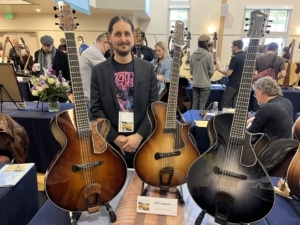7 Questions with Tyler Wells, LHT Guitars
Working alongside the great Tom Ribbecke and making truly original, playable works of art of his own design, LHT Guitars’ (Long Hair) Tyler Wells will be showing one of the new Blue Guitars at this year’s Archtop Guitar Festival in Colorado. We just caught up with him for some Q&A:
Tyler, you’re making one of the six new Blue Guitars to be shown at this year’s Archtop Festival. What can you tell us about it?
I’m going to be building what I call my Fugue model. It’s an asymmetrical, multiscale instrument. And I’m using some special materials for it; I kind of pay homage to Tom Ribbecke, who’s my mentor, and also a lot of the other archtop makers and luthiers in general who came before me and paved the way for what I’m doing.
We have previously featured Tom Ribbecke in our blog series, with whom you work. What is the single most influential thing you’ve learned directly from Tom or in being around his process?
I think probably that we all make mistakes, but that there’s almost nothing that you can’t recover from; so – to not beat yourself up about it when something happens. I think that’s probably the most valuable thing to me, in the sense that I’m trying to make a career doing this. Because sometimes you’ll screw something up, it happens. But to not lose sleep over it at night.
You plot out your own full scale blueprints before building, accomplish the build yourself, and even do your own finishes – wow! What single elements or stages in that process are your most and least favorites?
You know, that kind of changes. My favorite is probably the real big things; selecting and shaping the materials from raw wood, resawing billets. At the beginning, it seems like a lot happens pretty quickly. And as things become more refined, the work tends to slow down. So I think pulling materials and processing them into guitar parts is probably my favorite right now.
My least favorite part is probably sanding – especially ebony. Wet sanding isn’t so bad, but nobody likes wearing a dust mask.
How do you view the role of amplification in relationship to your instruments?
I think it’s important. But I also consider my archtops acoustic instruments, so I want them to sound good acoustically, but be easily amplified. So I think the role of amplification would be to have an amp that sounds like the instrument. I use magnetic pickups, which are not going to sound acoustic and have more to do with the electric guitar, and I know there’s some voodoo there with how woods affect tone in electrics, but I want to try to retain a semi-acoustic tone.
How has the reception of multiscale guitars been in the archtop community?
I think they’re coming around. A lot of people think of the archtop as a “jazz” instrument. People that view the instrument in that way may be less receptive, but I think people that are into the concept of the modern archtop are a little bit more receptive to it.
When are you happiest?
I suppose when I remember to take a moment and appreciate how crazy what I’m doing is. It’s so easy to get bogged down with minutia. Remembering to stop and reflect on where I’ve landed is important, because it’s pretty cool.
Tell us about the Roux bass and any future bass building plans. Are you yourself a bassist?
I’m not a bass player myself. But those instruments were a lot of fun to play when they were around. The Roux came about because I built a Roux guitar; a Charlie Hunter style 8-string, for a local guy named Nate Lopez. So that’s three bass strings, five guitar strings on one neck, and separate outputs for bass and guitar side of things. I had a client that saw that instrument, and said, “Hey, that would be really cool as a five string bass. Can you do it?” And I said, sure! The market seems to be small for that, but it’s pretty fun. I want to make more of those in the future.

